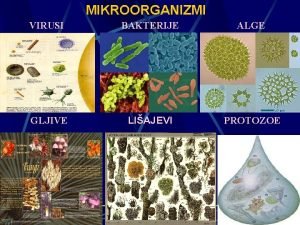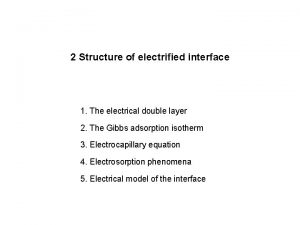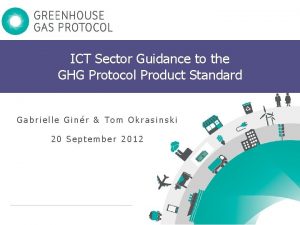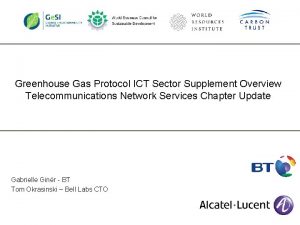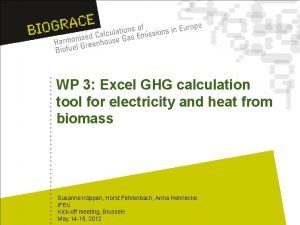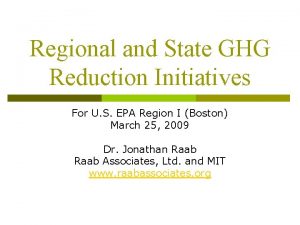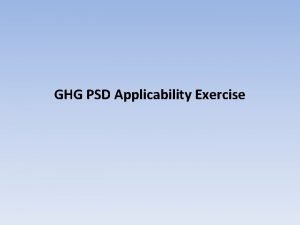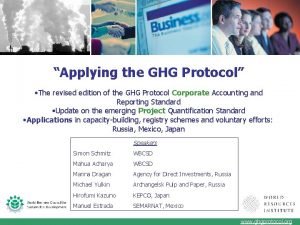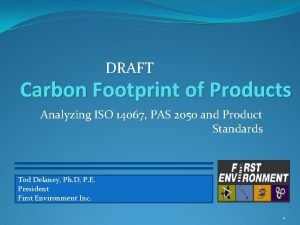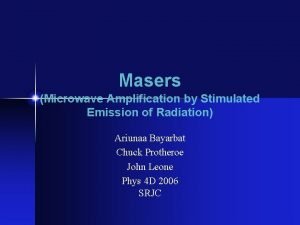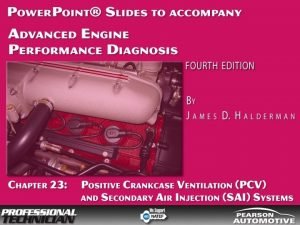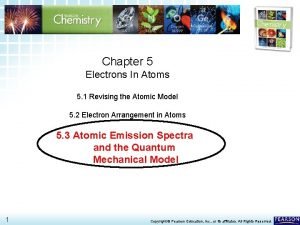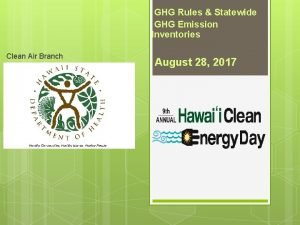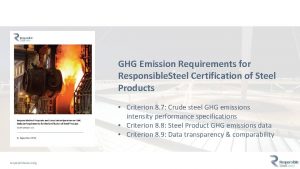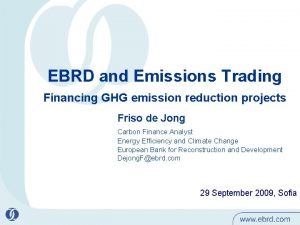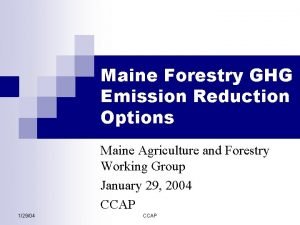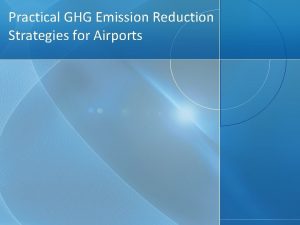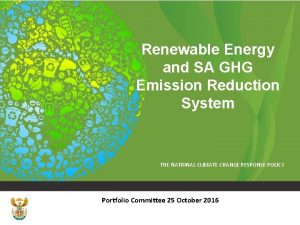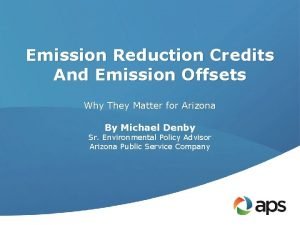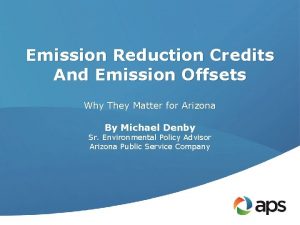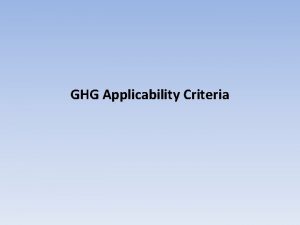WP 5 GHG emission reduction certification Stefan Majer













- Slides: 13

WP 5: GHG emission reduction (&) certification Stefan Majer, Maik Budzinski BIOSURF Kick-off, Palais Liechtenstein, Vienna, 26. 02. 2015

Introduction to WP 5 • In the recent years, the demonstration of GHG mitigation effects from the production and use of biofuels has gained significance importance • The EU RED 2009/28/EC has set mandatory GHG-mitigation thresholds for the use of biomethane as a transportation fuel and includes a methodology for the calculation as well as a number of default values: ◦ Biogas* from municipal organic waste 73% ◦ Biogas* from wet manure 81% ◦ Biogas* from dry manure 82% à Default values for Biomethane are limited to wastes and residues, no values available for biomethane from energy crops à The application of the RED methodology for biomethane provides some challenges and open questions 2

Main Objectives of WP 5 • Development of guidelines on calculating entitlement to CO 2 -certificates for the biomethane • Definition and assessment of a number of exemplary biomass-to-biomethanevalue-chains with regards to their environmental impacts. • Based on these assessments: - a number of recommendations for the adaptation of the RED GHG calculation methodology can be developed and - the most prominent drivers for emissions in the analysed biomethane pathways can be identified and described. 3

Main Objectives of WP 5 Data - potential methane emission reduction due to processing of: • organic waste, Methodology (acc. to EU RED) - allocation of by-products, - credits for avoided emissions, • agricultural by-products (incl. manure), - emission factors, - methane leakage, - etc. - substitution of mineral fertiliser, Ø discussion of best available data and highlighting further need for research Ø recommendations for the adaptation of the RED GHG calculation methodology 4

Activities and Tasks 5

Activities and Tasks Task 5. 1 Lead: AKB participants: EBA, FNR, HBA, DBFZ, GBA Methane emission reduction due to processing agri by-products • Analysis of emission reduction potential due avoided methane emissions caused by storage and application of untreated farm fertilizer and on methane emission caused by depositing animal by-products on landfills as well as C and N 2 O losses through catch crops and straw rotting process. 6

Activities and Tasks Task 5. 2 Lead: REA participants: DBFZ, EBA, GBA, FNR Methane emission reduction due to processing organic waste • Analysis of emission reduction potential from the use of organic waste in biogas units and thus avoided landfill site deposition.

Activities and Tasks Task 5. 3 Lead: AKB participants: DBFZ, FNR, GBA, EBA GHG emission saving due to replacement of chemical fertilisers • Detailed analysis of the GHG emission reduction potential achievable by applying the fermentation residue as organic fertiliser replacing industrial chemical fertilisers.

Activities and Tasks Task 5. 4 Lead: DBFZ participants: AKB, FNR, EBA, REA GHG emissions caused by biomethane production (Life Cycle Analysis) • • • Definition specific exemplary process chains (based on the information and results provided by tasks 5. 1 -5. 3 and WP 4) and assessment of their GHG-emissions and their GHG mitigation potential. Exemplary process chains will reflect country specific substrate compositions, supply scenarios as well as scenarios for the use of the digestate. As a result of these tasks a number of recommendations for the adaptation of the RED methodology to calculate GHG emissions will be given.

Activities and Tasks Task 5. 5 Lead: DBFZ participants: EBA, AKB, REA Methodology for entitlement to CO 2 certificates • The results of the work carried out in Tasks 5. 1 – 5. 4 will be integrated into Guidelines on calculating entitlement to C 02 certificates by biomethane producers.

Activities and Tasks Deliverables in WP 5 • D 5. 1: Recommendations for the adaptation of the GHG calculation methodology for biomethane systems included in Annex V of the EU RED (Month 18); • D 5. 2: Assessment of GHG reduction potentials due to the use of animal excrements and organic waste streams as biogas substrates and the replacement of industrial chemical fertilisers by digestate (Month 20); • D 5. 3: Methodology for the calculation and certification of GHG emission caused by the production of biomethane (in the whole Life Cycle) (Month 22); • D 5. 4: Description of the most prominent drivers of emissions in LCA for biomethane production (Month 24); • D 5. 5: Comprehensive Methodology on calculating entitlement to CO 2 certificates by biomethane producers (Month 30).

Time schedule and next steps • First proposal to discuss the exemplary process chains for the LCA in Task 5. 4 • Discuss main input parameters for LCA to be provided by Tasks 5. 1 -5. 3 • Begin Literature review on upstream emissions from synthetic fertiliser production

Researching the energy of the future – come and join us! Contacts Stefan Majer Phone: +49(0)341 2434 – 411 E-Mail: stefan. majer@dbfz. de Maik Budzinski Phone: +49(0)341 2434 – 133 E-Mail: maik. budzinski@dbfz. de DBFZ Deutsches Biomasseforschungszentrum gemeinnützige Gmb. H Torgauer Straße 116 D-04347 Leipzig Phone: +49 (0)341 2434 – 112 E-Mail: info@dbfz. de www. dbfz. de
 Tajni dnevnik malog perice
Tajni dnevnik malog perice Ewa majer
Ewa majer Sterilizacija plamenom
Sterilizacija plamenom Structure of electrified interface
Structure of electrified interface Ghg protocol ict sector guidance
Ghg protocol ict sector guidance Ghg protocol ict sector guidance
Ghg protocol ict sector guidance Biograce
Biograce U.ghg
U.ghg Ghg exercise
Ghg exercise Ghg protocol revised
Ghg protocol revised Iso 14067 vs ghg protocol
Iso 14067 vs ghg protocol Microwave amplification by stimulated emission of radiation
Microwave amplification by stimulated emission of radiation The pcv system controls which exhaust emission(s)?
The pcv system controls which exhaust emission(s)? Atomic emission spectra and the quantum mechanical model
Atomic emission spectra and the quantum mechanical model


